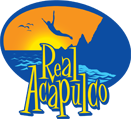Zihuatanejo & Ixtapa
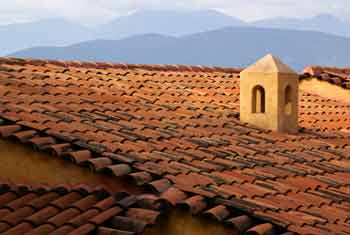
Zihuatanejo and its neighbor, the modern tourist resort of Ixtapa just a couple of miles to the north, are vacation destinations on the Mexican Pacific coast about 150 miles (240 km) north and west of Acapulco. Zihuatanejo is the state of Guerrero’s fourth largest city with approximately 65,000 permanent inhabitants. Each area has miles of sandy beaches in neighboring bays. Some say Zihuatanejo is a “little Acapulco,” as it is an older city that welcomes tourists, while Ixtapa is a “little Cancún,” in that it is a recently built, planned resort.
The name Zihuatanejo is a modern version of “Ciguatanjeo,” the Spanish rendering of the Nahuatl name “Cihuatlán.” The Nahuatl name means “the place of women,” presumably because the pre-Columbian society and culture there was matriarchal. According to ancient legend a great leader named Caltzontzin built a rock breakwater at one of Zihuatanejo’s beaches, thus creating calm waters in which the women and children could bathe, free of worries about currents and dangerous sea life. In fact, this natural harbor was probably created over centuries by the sea itself. The place is called “Playa las Gatas” (a “gata” is a nurse shark) because these harmless, whiskered sharks were very numerous here before humans took over. Some Spanish conquistadores thought that Cihautlán was a land of beautiful women and lots of treasure – perhaps even another name for the famous Seven Lost Cities of Cibola. In fact, the conquistadores were just a little too early – the beautiful women and the treasure did not arrive until the era of modern tourism late in the 20th century. Zihuatanejo gained notoriety as the place to which the two heroes eventually escape in the Stephen King novel and movie, Shawshank Redemption. In the movie, Morgan Freeman’s character, Red, reacts to hearing the name for the first time with “See-what?” The phrase has become something of a password amongst the English-speaking visitors who have come to know and love this destination.
Getting to Zihuatanejo-Ixtapa
Zihuatanejo’s airport is served by national and international airlines. Most are connections through Mexico City, but others come from the US and Canada, as well as from other locations like Acapulco and Guadalajara. The latter are more like commuter flights. A good many charter flights land in Zihuatanejo-Ixtapa, operated by Apple Vacations, Funjet Vacations, Ryan International, and several others. Most Mexican tourists arrive in Zihuatanejo by car or bus. Federal Highway 200 runs through Zihuatanejo, coming from Acapulco in the south, up towards Michoacán and Jalisco to the north. There is a more direct road from Mexico City, though some of the segments are fairly narrow and curvy. The major bus lines serve this destination with several daily arrivals and departures. Costa Line, Turistar/Futura (Estrella Blanca) and Estrella de Oro are among them.
Zihuatanejo
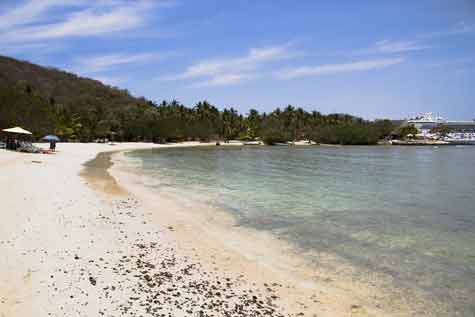
Until about 1975 Zihuatanejo was a small village that supported itself mainly by fishing and hosting the occasional tourist looking for a remote place to hide away. Today fishing is still important to the lifestyle of the place, but sport fishing has come to mean a great deal more to the local economy, as visitors from all over arrive in search of marlin, sail fish and other trophies. Another type of visitor is the “cruiser” – persons who live aboard their boat and travel from place to place, mooring for short times at different locations. Many take pleasure in spending their winter months in the calm waters of Zihuatanejo’s bay, enjoying the tropical sun at its very best. The old center of Zihuatanejo may seem a bit dowdy by comparison the beach locations, as it is the unreconstructed part of town. It is still very traditional in both its layout and in terms of all the many things you can buy there.
Zihuatanejo Beaches
Zihuatanejo bay is a large, elliptical, natural harbor about 5.5 miles (9 km) wide. The main beach of the town is called, unimaginatively, “Playa Principal” at the north end of the bay. This is where the fishermen dock and where they return with their catch to sell into the local markets. The constant effort of tending to nets and fishing vessels goes on here, making Playa Principal a very busy place. The “Paseo de Pescador” (fisherman’s path) connects the town docks with the museum of archeology, about a quarter of a mile away. This pedestrian passage leads to numerous shops, bars and open air stands that sell folk art, things to eat and trinkets of all kinds. The town plaza or Zócalo looks out over this paseo to the beach.
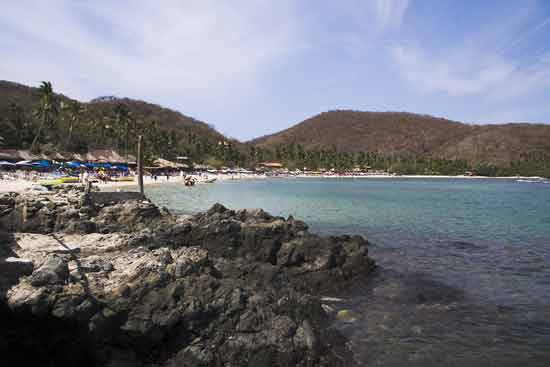
“Playa la Madera” is adjacent to Playa Principal to the east and south. It is a small beach with a sandy shore, and can be reached either over the rocks from Playa Principal or directly from the street. The waves are calm – just right for families. A couple of restaurants and hotels are on the beach or just above and behind it on the hill. It is named because lumber taken from the mountain forests was shipped out on galleons moored there. “Playa la Ropa” is a wide sandy beach to the eastern side of the bay, perhaps the most beautiful beach in the whole area. The sandy bottom and gentle currents make this the ideal swimming beach. Like Playa la Madera, Playa la Ropa has plenty of seafood restaurants and more than a couple of hotels. This is a good beach to use as your base for all water sports (like the banana boat or jet skis). It is named because clothes from a wrecked galleon washed up on shore there.
“Playa las Gatas” is a small, pleasant beach, named because it was once a haven for nurse sharks (called “gatas” because of their whiskers). On the southern side of the bay there is a small, natural cove that makes for excellent swimming and snorkeling. Restaurants and bars in the several palapas provide seaside food and beverage service as well as umbrellas, chairs and lounges. A water taxi runs between Playa las Gatas and the town pier. “Playa Larga” or “Long Beach” is outside the bay on the open sea. The beach is well named. It is both wide and very long (7½ miles or 12 km), with a sandy bottom, so it is very good for swimming. Lots of people enjoy jogging and horseback riding along this beach. At the very far end of this beach is the fishing village of Barra de Potosí. Beyond this small town is Playa Blanca. Here one can find a large mangrove lagoon, which drains to the sea. Barra de Potosí offers many palm-thatched, fresh air seafood restaurants, complete with lots to drink and a hammock in which to sleep it off.
Ixtapa
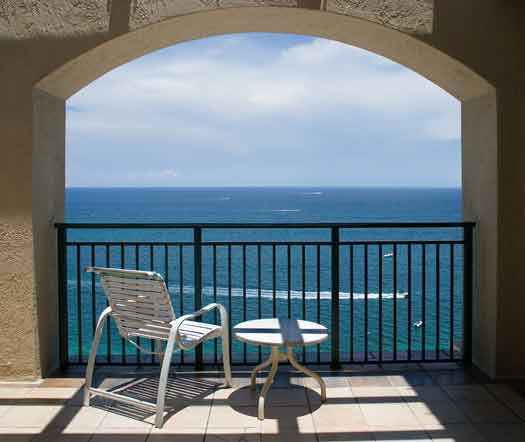
Ixtapa is a place, not a city. FONATUR, a tourism-promoting agency of the Mexico’s federal government, planned the resort and built it over several years. FONATUR also manages the area, including the supervision of land development and real estate sales as well as construction of public assets (like roads, streets and piers) and the provision of public services. Ixtapa is just up the coastal road from Zihuatanejo about four miles. From the ocean, it is just one bay north of the bay at Zihuatanejo. Ixtapa offers the visitor some very upscale boutiques and shops in modern shopping centers. Several tall buildings of condominium apartments line the beach, together with a large number of luxury hotels. In most condominiums and in several of the hotels a visitor can acquire a time-share interest in a unit. The remaining space is occupied by lots of seaside bars and restaurants, as well as a few nightspots. Ixtapa also operates a large and well-equipped marina. Behind the beach buildings and across the coastal avenue are quieter neighborhoods in which the permanent residents make their homes. Here one can find bed & breakfast accommodations and smaller hotels. Ixtapa has two highly respected 18-hole golf courses and lots of options for racquet sports as well. Additionally, tourists can spend their days with water sports on the bay – sailing, skiing, parasailing and wave-running. They can also take off into the deep waters on fishing excursions. The adventurous may want to make an outing to Troncones, a tiny fishing village about thirty miles (55 km) north of Ixtapa. This place has been a popular eco-tourism destination for well over a decade. These days it shows a few signs of development – like small hotels and seafood restaurants – but its beaches and coastal areas remain natural. The natural habitat of Troncones has not yet changed dramatically from what it was centuries ago.
Ixtapa Beaches
El Palmar is the name of the principal beach of Ixtapa. It is about a mile and a half long and is very smooth, sandy and inviting for beach walking. Most of Ixtapa’s important beach front hotels are on El Palmar, so it is synonymous with the “Hotel Zone” or “Zona Hotelera.” The bay at Ixtapa is not closed – it is more of a scallop in the coastline, facing the open waters of the Pacific. As a result, this beach has substantial waves and can be excellent for surfing. It may be a little too much for small children. As you walk south, towards Zihuatanejo, the waters become a bit calmer because large rocks and a ridge line come down towards the sea to protect a portion of the beach. El Palmar is good for people-watching, as each hotel puts out its umbrellas and lounges and the staff members serve drinks and food while other staff members organize activities for their guests. The terrain in between each hotel has been left natural, by direction of the Master Plan for Ixtapa. The beach along the hotel zone also provides perfect, unobstructed views of the gorgeous sunsets over the Pacific horizon. Two small rock formations called “Los Morros” are just offshore.
A secondary hotel zone is found at Playa Quieta, just up the beach – north and west -- from El Palmar. Like its neighbor, Playa Quieta is smooth and sandy. The waters are quite calm, and therefore they attract kayakers, snorkelers, swimmers and windsurfers. Three hotels border this beach, which is just a few minutes’ ride by car from El Palmar.
North and west of Playa Quieta is Playa Linda, a very calm beach with fine, white sand. From this beach you can take a water taxi across to Ixtapa Island, which lies just off the shore. Horseback riding is available, permitting you to visit a coconut plantation and to pass through some tropical jungle terrain. Also by Playa Linda is a small, native mangrove lagoon, locally known as “El Cocodrilario” – or Croc house. Isla Ixtapa. Taking a small boat from Playa Linda, in about 10 minutes you will set foot on Isla Ixtapa. The island is natural, covered with native forest. Four small and isolated beaches can be found here. There are services for food and beverage, as well as opportunities for scuba diving, snorkeling and motorized sports. The main beach is called Cuachalalate. Varadero and Coral are smaller ones with restaurants on them as well. Varadero faces right into the sunset. Coral has really clear water for snorkeling. Playa Cary is the most secluded and remote of the four. Be careful about the time. The last ride to the mainland leaves at 5:00 pm.
Activities

Zihuatanejo and Ixtapa offer a good bit of excitement for those who are looking for something more than just lying in the sun. Naturally, all other water sports are options than can easily be arranged: scuba diving, snorkeling, sport fishing, windsurfing, body surfing, surfboarding, sailing, water skiing, jet-skiing – all are open to the visiting tourist. In addition, it is fun to get out into the terrain around the water with hiking, horseback riding and sightseeing tours. Add to this golf and tennis as well as recreational shopping, eating and drinking, and it will be easy to fill up every day with fun. The two communities of Zihuatanejo and Ixtapa also offer a lively experience after dark as well.
Self-guided tours are very popular. One of them is to El Faro – the lighthouse on Playa las Gatas. Walk to the far end of Playa las Gatas, where the Beach Club is located. There is a flagstone path that goes towards to lighthouse. If you do not see it right away, anyone who works there can direct you. The walk takes about 15 minutes, mostly uphill. The view from the cliffs overlooking the ocean is magnificent. You will also get a good sense of all the different islands along this part of the coast – Los Morros de Potosi in the south, just of Playa Blanca to the islands in front of Ixtapa itself towards the north. Out in front you will see La Piedra Solitaria, about a half mile out in the ocean from Zihuatanejo’s bay. It is a tiny island with a beacon, which can be seen after sunset.
Some visitors enjoy an excursion to Petatlán, a very old and traditional center of ranching and agriculture on the coastal road towards Acapulco. It takes about 40 minutes to get there by car. Buses go there, too. Important sites include the exquisite church and the open-air gold market out in front. Tourists will be able to see many vestiges of Petatlán´s colonial past. Some archeological sites can be found nearby, and their artifacts are on display throughout the town. If you are in town for Semana Santa (the week before Easter), Petatlán is really worth the special effort to go there because of its famous “Feria de Semana Santa” – a large open-air market event for Holy Week with every kind of art, artisan work, food and clothing on display and for sale. The Petatlán bus (Ómnibus de Petatlán) leaves Zihuatanejo from a stop behind the Jaiba Feliz restaurant on Benito Juarez Street. You need to ask to get off at the street going to the town square or “Zócalo.” It’s about four or five blocks to the center of town. Remember where you got off, as that’s where the bus will stop to pick you up.
If you decide to venture south to La Barra de Potosí off Playa Blanca, follow the coastal highway (Federal 200) for about 25 minutes to Los Achotes. This is a tiny town on the highway. Go right at the sign for the Laguna de Potosí (right past the bridge) and then left at the shore. You’re there when you run out of road. Here there are several really wonderful seafood restaurants and a calm and quiet beach. Boat tours of the lagoon estuary are available, and you will be able to see lots of tropical wildlife, particularly birds like herons, spoonbills and white pelicans (which are extremely rare). Small mammals and medium-size reptiles (like crocodiles) are often spotted, too. This tour will be especially important for ecologists and photographers.
Shopping
Zihuatanejo and Ixtapa present a full range of shopping options for those who enjoy browsing the shops and stores when on vacation. Both locations have open-air markets of folk art, traditional handicrafts and souvenirs. In Zihuatanejo it is found on Calle Cinco de Mayo by the church. In Ixtapa it is at the south-eastern end of the main hotel zone. Each has perhaps two hundred or more booths with ceramics, rugs, leather goods, tapestries, masks, crafts of wood, stone or metals, and many other keepsakes. The Mercado Central of Zihuatanejo is enormous. Here in the early part of the day one can buy fruit, vegetables, fresh seafood, spices and everything else for cooking. Then, in the center of Zihuatanejo and in the village area of Ixtapa once can find shopping malls, including boutiques with tropical fashion and the latest in casual and sport clothing. Home furnishings and more upscale native art are also for sale in these centers. In addition several shops offer fine silver jewelry, tableware and articles for the home, crafted by the renowned silversmiths of Taxco.
Nightlife
Ixtapa-Zihuatanejo is more of a tourist destination than a party town. Nevertheless, local nightspots offer a variety of options for fun after dark. Zihuatanejo provides several choices for the small, cozy, quiet bar in which it is easy to have a relaxed conversation. Others are more like lounges with DJ’s, dancing, and open spaces with grand views. A third possibility is the romantic bar, in which offers quieter music. Often a live singer will entertain with ballads, trovas and boleros. You can chose to go to a “canta-bar” (karaoke) if that is your pleasure, or seek out the Latin rhythms of salsa, meringue and other dances. In Ixtapa you can find the “after-hours” bar and the lively discos. Dance clubs open their doors around 10 pm and stay active until dawn or even after. Whether you seek to chat, to romance, to dance or to party, you should be able to find what you are looking for in Ixtapa and Zihuatanejo.
